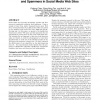Free Online Productivity Tools
i2Speak
i2Symbol
i2OCR
iTex2Img
iWeb2Print
iWeb2Shot
i2Type
iPdf2Split
iPdf2Merge
i2Bopomofo
i2Arabic
i2Style
i2Image
i2PDF
iLatex2Rtf
Sci2ools
CIKM
2009
Springer
2009
Springer
A co-classification framework for detecting web spam and spammers in social media web sites
Social media are becoming increasingly popular and have attracted considerable attention from spammers. Using a sample of more than ninety thousand known spam Web sites, we found between 7% to 18% of their URLs are posted on two popular social media Web sites, digg.com and delicious.com. In this paper, we present a co-classification framework to detect Web spam and the spammers who are responsible for posting them on the social media Web sites. The rationale for our approach is that since both detection tasks are related, it would be advantageous to train them simultaneously to make use of the labeled examples in the Web spam and spammer training data. We have evaluated the effectiveness of our algorithm on the delicious.com data set. Our experimental results showed that the proposed co-classification algorithm significantly outperforms classifiers that learn each detection task independently. Categories and Subject Descriptors H.3.3 [Information Storage and Retrieval]: Information Se...
| Added | 14 Aug 2010 |
| Updated | 14 Aug 2010 |
| Type | Conference |
| Year | 2009 |
| Where | CIKM |
| Authors | Feilong Chen, Pang-Ning Tan, Anil K. Jain |
Comments (0)

